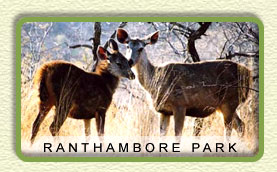 |
| YOU ARE HERE : North India Travel Packages > Wildlife Attractions In Northern India > Wildlife Parks In North India > Ranthambore National Park |
Ranthambore National Park
Ranthambore National Park is part of the much larger Ranthambore Tiger Reserve, and lies in the Sawai Madhopur district of Eastern Rajasthan, a state in North western India. Ranthambore is one of India's most popular national parks  because the chance of seeing a tiger in the wild, is greater here. Ranthambore is an important conservation area for Indian Wildlife. The Chambal River forms a natural boundary of the park towards the east, and to the northeast of the park flows the Banas River - a tributary of the Chambal.
because the chance of seeing a tiger in the wild, is greater here. Ranthambore is an important conservation area for Indian Wildlife. The Chambal River forms a natural boundary of the park towards the east, and to the northeast of the park flows the Banas River - a tributary of the Chambal.
Ranthambore's royal past manifests itself in the picturesque ruins the dot the Park. There are lake palaces, chhatris, old fortifications and a majestic thousand year old fortifications and a majestic thousand year old fort on a height overlooking the Park. The forest rest house at the foot of the Ranthambore fort is located in the lovely Jogi Mahal. It overlooks a tank the pretty Padam Talao, afloat with water lilies.
A heaven for a multitude of wild animals, the park boasts of playing host to tigers, leopards, the elusive caracals, striped hyenas, sloth bears, jungle cats, wild boars, crocodiles and so on. Besides, there are over 300 species of birds, from the rare Indian Courser to the beautiful Painted Sand Grouse. You can go for National Park rides, jeep safaris, camel rides, bird watching excursions and nature walks.
October to March. The park is closed from June to October. While May and June are hot, the increasing scarcity of water as summer approaches makes wildlife sighting easier as the animals flock to the water holes.
Sawai Madhopur is a small rural town, and serves as a market for the rural hinterland. It is known for its winter guavas, red chilies and mustard. Besides this, tourism and transportation are the mainstays of the local economy. Ranthambore National Park is contiguous with the Sawai Madhopur town, and the gate from where tourists enter the park, is about 12 kms from the heart of the town. Once a tiger came into town, and had to be tranquilized and was released back into the park. The small town of Sawai Madhopur does little to prepare a first time visitor, to the remarkable merging of nature and history. Overrun by vegetation, the scattered remnants of chattris, graves, step wells, summer palaces and crumbling guard posts can still be seen - a historic past set within a wild present. The entrance to the park is through an old stone gate with battlements on either side constructed originally to protect the Kings of Ranthambore. Now it protects a magical world whose value is unimaginable - one of the most beautiful tiger habitats of the world. This land where endless battles were fought between warring Kings, has another ruler - the tiger - India's national animal and the symbol of Indian Wildlife.
As Ranthambore is a dry deciduous forest, wildlife is invariably concentrated near water. This is what makes sighting animals so easy in Ranthambore. A chain of three lakes and streams and rivulets that criss-cross the park attract the ungulates and the carnivores. Often tigers walk through the grass at the edge of the lakes in anticipation of a kill. The lakes have marsh crocodiles, and there have been conflicts between tigers and crocs. Some years back tourists watched an epic battle between these two predators - the crocodile paid the price by losing its life.
Fishes in Ranthambhore
Ranthambore due its numerous water bodies has a relatively large variety of fish to boast of. These species consist of : Bita (Labio Rohita), Catla (Catla catla), Greyei (Chhana matulion), Lanchi (Walago auto), Mahseer (Tor tor), Mirgal (Cirrchinus mrigala), Rohu (Labio rohita), Savank (Chhana punctatus), Seenghari (Mystus seenghala).
How To Reach Ranthambore
 because the chance of seeing a tiger in the wild, is greater here. Ranthambore is an important conservation area for Indian Wildlife. The Chambal River forms a natural boundary of the park towards the east, and to the northeast of the park flows the Banas River - a tributary of the Chambal.
because the chance of seeing a tiger in the wild, is greater here. Ranthambore is an important conservation area for Indian Wildlife. The Chambal River forms a natural boundary of the park towards the east, and to the northeast of the park flows the Banas River - a tributary of the Chambal. Ranthambore's royal past manifests itself in the picturesque ruins the dot the Park. There are lake palaces, chhatris, old fortifications and a majestic thousand year old fortifications and a majestic thousand year old fort on a height overlooking the Park. The forest rest house at the foot of the Ranthambore fort is located in the lovely Jogi Mahal. It overlooks a tank the pretty Padam Talao, afloat with water lilies.
A heaven for a multitude of wild animals, the park boasts of playing host to tigers, leopards, the elusive caracals, striped hyenas, sloth bears, jungle cats, wild boars, crocodiles and so on. Besides, there are over 300 species of birds, from the rare Indian Courser to the beautiful Painted Sand Grouse. You can go for National Park rides, jeep safaris, camel rides, bird watching excursions and nature walks.
Best time to visit Ranthambore National Park
October to March. The park is closed from June to October. While May and June are hot, the increasing scarcity of water as summer approaches makes wildlife sighting easier as the animals flock to the water holes.
Sawai Madhopur is a small rural town, and serves as a market for the rural hinterland. It is known for its winter guavas, red chilies and mustard. Besides this, tourism and transportation are the mainstays of the local economy. Ranthambore National Park is contiguous with the Sawai Madhopur town, and the gate from where tourists enter the park, is about 12 kms from the heart of the town. Once a tiger came into town, and had to be tranquilized and was released back into the park. The small town of Sawai Madhopur does little to prepare a first time visitor, to the remarkable merging of nature and history. Overrun by vegetation, the scattered remnants of chattris, graves, step wells, summer palaces and crumbling guard posts can still be seen - a historic past set within a wild present. The entrance to the park is through an old stone gate with battlements on either side constructed originally to protect the Kings of Ranthambore. Now it protects a magical world whose value is unimaginable - one of the most beautiful tiger habitats of the world. This land where endless battles were fought between warring Kings, has another ruler - the tiger - India's national animal and the symbol of Indian Wildlife.
As Ranthambore is a dry deciduous forest, wildlife is invariably concentrated near water. This is what makes sighting animals so easy in Ranthambore. A chain of three lakes and streams and rivulets that criss-cross the park attract the ungulates and the carnivores. Often tigers walk through the grass at the edge of the lakes in anticipation of a kill. The lakes have marsh crocodiles, and there have been conflicts between tigers and crocs. Some years back tourists watched an epic battle between these two predators - the crocodile paid the price by losing its life.
Fishes in Ranthambhore
Ranthambore due its numerous water bodies has a relatively large variety of fish to boast of. These species consist of : Bita (Labio Rohita), Catla (Catla catla), Greyei (Chhana matulion), Lanchi (Walago auto), Mahseer (Tor tor), Mirgal (Cirrchinus mrigala), Rohu (Labio rohita), Savank (Chhana punctatus), Seenghari (Mystus seenghala).
How To Reach Ranthambore
- Air
Jaipur at 145 km is the nearest airport from Ranthambore wildlife sanctuary. - Rail
Ranthambore National Park is around 11 km away from Sawai Madhopur railway station, that lies on the Delhi to Bombay trunk route. - Road
A good network of buses connect Sawai Madhopur, the nearest town from Ranthambore to all the major cities within the state of Rajasthan.
| Recommended Tour Itineraries |
| -->
Tiger Trails in India Duration : 14 Days / 13 Nights Destination Covered : Bombay - Nagpur - Kanha - Bandhavgarh - Khajuraho - Agra - Ranthambhore - Jaipur - Delhi --> India Wildlife Tours Duration : 23 Days / 22 Nights Destination Covered : Delhi - Sariska - Jaipur - Ranthambore - Bharatpur - Agra - Khajuraho - Bandhavgarh - Kanha - Nagpur - Bhubaneshwar - Kokatta - Gauhati - Kaziranga - Delhi --> Tiger Tour Packages Duration : 15 Nights/ 16 Days Destination Covered : Delhi - Sawai Madhopur - Rathambore National Park - Bharatpur Bird Sanctuary - Agra - Umaria - Bandhavgarh National Park - Kanha National Park - Nagpur - Delhi - Corbett National Park - Delhi |
| North Indian Tourist Destinations |
| Monuments in North India |
| Hill Stations in North India |
| Wildlife Attractions In Northern India |
| Guide to Forts & Palaces |
| Pilgrimage Destinations In Northern India |